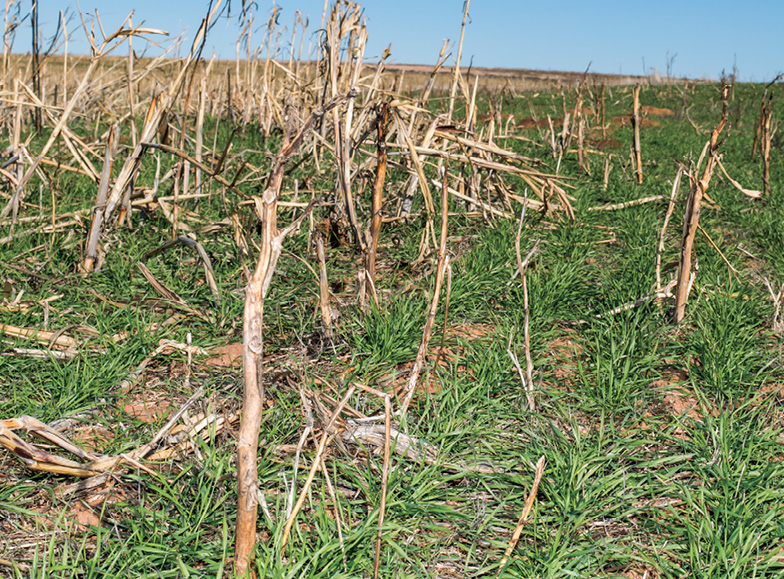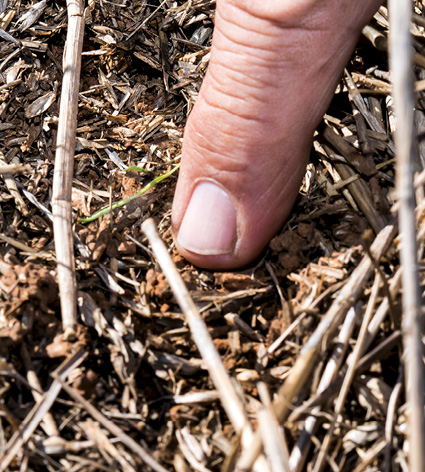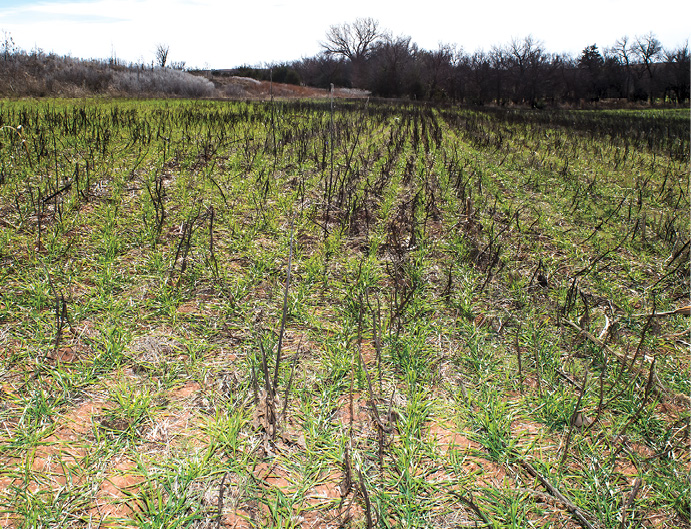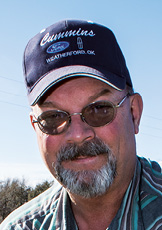FIXING SOILS. Jimmy and Ginger Emmons have been no-tilling for 20 years and added cover crops 3 years ago to boost soil health on their 2,000-acre farm near Leedey, Okla. They also run a 220-head cow-calf operation on a rotational grazing system.
When Jimmy Emmons talks about the major changes he’s making to his farm, he feels compelled to explain that his father and grandfather, “did the best they could do with the equipment they had.”
But when he and his wife, Ginger, took over the family’s third-generation farm in Leedey, Okla., they faced the task of rehabbing soils that were mined of nutrients and badly degraded from decades of tillage.
They’re now finding themselves in a different boat. They’ve been no-tilling for 20 years, added a rotational grazing system for their cow-calf operation and also spent 3 years implementing cover crops on their 2,000-acre farm. It’s not a path many farmers around them have chosen — yet. But Jimmy knows who he is.
“When I look at a cover crop out there, I don’t think I’m a trash farmer. I’m looking at a lot of potential,” he says. “I’m looking at storing twice as much water in the soil, and spending half as much time plowing and wearing out that equipment.”
Jimmy started no-tilling the farm in 1995 to control wind and water erosion, improve nutrient-use efficiency and increase organic-matter levels.
At the beginning, they started doing more in-depth soil testing to establish a baseline for pH levels and soil microbial activity and found fields were in varying condition.
 |
| GREENING UP. Wheat emerges through cover-crop stubble on Jimmy Emmons’ farm. He seeded a 14-way cover-crop mix last year that included buckwheat, sunn hemp, Egyptian wheat, Clemson okra, sunflowers, forage collards, Bayou kale, guar, BMR sorghum-sudangrass, crimson clover and proso millet. |
The Emmonses have soils that range from white sand to dark, heavy clay to red, uphill land near their home. But no-till had a role to play in their rehabilitation, Jimmy says, noting, for example, some river-bottom land that wasn’t even farmed by his grandfather because it was prone to blowing or washing away.
“Today, we farm it all and made it highly productive. This land can be productive if you get it straightened out,” he says. “We had to do some smoothing out of sandy knobs as we went into no-till. From there, we started working on getting the pH better and trying to raise organic matter.”
Making Adjustments
Weather often dictates what Jimmy can do with their rotation. Their farm typically sees 22-25 inches of rainfall annually, although much of that comes in the form of intense rainstorms. And drought is always a threat: their area only received 11 inches of rain in 2012 as a multi-year dry spell began that also featured extreme heat.
Typically, wheat and cattle are the money makers on the farm. During the prolonged drought, the Emmonses dropped milo and rotated in winter canola to avoid the intense summer heat.
But with state climatologists noting recent changes in weather patterns to a drier winter and wetter summer and fall, Jimmy added soybeans to the rotation last year and plans to plant milo this year.
Jimmy usually seeds wheat Sept. 15-20, or possibly later in fields where cover crops are being grazed. He typically applies SureCrop fertilizer, a 9-23-7, in-furrow with micronutrients and does split applications of nitrogen (N) throughout the growing season, starting in the fall with a streamed application of 8-10 gallons per acre.
The Emmonses are experimenting with sunflowers, raising them along with cowpeas on 40 acres after wheat last year to gauge the feasibility of raising companion crops. Jimmy’s planning to do this on a little bigger scale this year and harvest the sunflowers.
He also seeded soybeans after wheat for the first time in 25 years and managed to see yields in the upper 40s to lower 50s in bushels per acre. He may up his soybean plantings to 300 acres for this year.
He’s also lengthening the time between raising alfalfa in his rotation in hopes of building up organic matter in some fields.
“Alfalfa will put N back in the soil, but you’re cutting and hauling it off all the time,” Jimmy says. “I used to leave it out as long as I could to maximize that first cost, but now it will be 5-6 years max and back out so we can better capture N and not keep lowering organic matter.
“On one of the farms that had irrigated alfalfa we’ve been doing some cover crops, and I got back the new grid samples and we’ve doubled the organic matter in some areas in 2 years. I’m pretty excited about that.”
Using the Window
As Jimmy gets deeper into the rotational changes, he wants to be ready to get cash crops in when soil and moisture conditions are right.
“If it’s a 50- or 90- or 190-day window, I want to plant a crop that can fit and not just be stuck on wheat or an exact rotation,” Jimmy says. “I want to be flexible for markets, weather and timing.”
He says that’s an extreme mind shift for many farmers and landlords in western Oklahoma because continuous or dual-purpose wheat has dominated for decades.
“It’s easy. It’s pretty forgiving on planting times,” he admits. “But there’s a big difference between planting wheat and growing wheat. If you’re trying to intensively manage and grow it through the year, there are bigger opportunities to capture more yield.
“We’re all learning and trying to share that a bit. We’ve seen a jump in production with cover crops that is eye opening for some of these guys.”
The rotation changes and addition of cover crops has implications for the Emmonses’ equipment. Jimmy has been seeding crops with a Great Plains Mfg. 3000HD drill, and while the 30-foot unit has performed fairly well, Emmons traded it in for a 40-foot Great Plains 4000HD.
“We had some issues working in high levels of residue, because some of the cover crops were hood high or cab high and we had some problems getting those knocked down at planting,” he says.
“Great Plains Mfg. sent some engineers and an area representative out here and spent the day with us, went back to headquarters to get some experimental stuff and put that back on our unit, and that was the solution on the knock downs.”
The Emmonses may eventually add a planter to their equipment lineup to improve stands for soybeans and milo.
“I would have liked to go with an air seeder, but I want liquid fertilizer and most of them only handle dry, or have liquid but the hydraulic flow requirements are higher,” Jimmy says.
Taking the Plunge
 |
| DOING THE JOB. Oklahoma no-tiller Jimmy Emmons points to earthworm middens in a field of emerged wheat. Emmons has started doing more in-depth soil testing to establish a baseline for pH levels and soil microbial activity on his 2,000-acre farm, featuring soil types from white sand to heavy clays to uphill land. |
The subject of cover crops is a controversial one in the semi-arid Great Plains, as many no-tillers worry seeding them in summer after wheat harvest will use up moisture needed for cash crops.
But Jimmy says his experiences with covers on his own farm have been much different — so much so that he’s spending a good deal of time traveling and speaking at field days to other farmers about cover crop benefits and how they fit in with his livestock program.
Jimmy got hooked into cover crops several years ago while hearing discussions about soil health at a National Assn. of Conservation Districts meeting and the potential to reduce nutrient expenses by growing nutrients on his own with covers.
“That really put a fire in me. I was looking for some help and I knew what I wanted to do, but I didn’t know much,” he says.
He came home and began discussions with Oklahoma NRCS state conservationist Gary O’Neill and NRCS state soil scientist Steve Alspach about making his operation a demonstration farm for both cover crops and rotational grazing.
In 2012, to test his presumptions about cover crops, Jimmy used a bare spot in one of his wheat fields as a sort of check strip. After seeding wheat in the field that fall, he turned cattle in on it for grazing and planted cover crops everywhere but in that spot after wheat harvest.
The following spring, a soil core taken by Noble Foundation soils and crops consultant Jim Johnson inside the circle showed a restriction at 16 inches, and the core had dry dirt on the bottom of it.
Johnson then took a shovel and dug into the dirt all around the bare spot where covers were present and couldn’t hit dry dirt, Jimmy says.
Additional cores taken by the NRCS found wet soil down to 34 inches in spots surrounding the bare spot. Lab tests found 4.6 inches of soil water in the bare spot, and 7.52 inches in the cover-cropped soil.
Jimmy also notes wheat in the cover-cropped field made 32 bushels an acre, much higher than neighbors who were cutting 16-18 bushel wheat.
“That’s the water bank where the cover crop is, and you’d better believe it makes a difference in the bottom line of what we’re going to haul to town, whether it’s cattle or grain,” he says.
Jimmy also set up moisture and temperature probes inside the circle and outside. Temperatures in the bare ground reached 120-125 F in summer, and cover-cropped soil was in the 90s F.
“Everybody told me cover crops won’t work, because if you’re growing a crop they will burn water. Well, you do use some water. But you’re going to evaporate twice as much as you’re using,” with bare soils, Jimmy says. “With covers you’re going to store up more water and help that infiltration.”
Jimmy has gradually increased the diversity of covers he’s seeding, going from 6- or 7-way mixes a few years ago to the 14-way mix seeded last year.
That seeding included, among other things, buckwheat, sunn hemp, Egyptian wheat, Clemson okra, sunflowers, forage collards, Bayou kale, guar, BMR sorghum-sudangrass, crimson clover and proso millet.
He chose the Egyptian wheat for increasing organic matter, buckwheat for benefitting pollinators, okra for deep rooting and sunflowers for its large taproot.
In November he and Alspach dug up sunn hemp plants and found some had quarter-size N-fixing nodules on them. The collards, proso millet and okra have potential for grazing, Jimmy says.
He planted all broadleaf covers in one field last year, with the theory a change in the carbon-N ratio would allow residue to cycle over more quickly and provide a friendlier seedbed for winter canola — although he wasn’t able to seed it last year.
Jimmy says he knows by letting cover crops grow to maturity and grazing them later that they will use more soil water, but as infiltration improves in his no-tilled soils, many fields are projecting to be in a water surplus in a few years.
And in his region, water is the key to yields and profits.
 |
| SWITCHING COVERS. Sunflowers and cowpeas were planted after wheat in this field on Jimmy Emmons’ farm last year as part of an experiment he’s conducting with raising companion crops. He is considering planting sunflowers on more acres this year to harvest them as a cash crop. |
“To me it’s black and white what we have to do for the future, for the bottom line and everything. I think we’re on the right track,” he says.
More Per Acre
Implementing a rotational grazing system for livestock figures to be another leg of the Emmonses’ diversified farm. They have a 220-head cow-calf operation that they graze on cover crops during winter.
Like with cover crops, Jimmy needed some technical assistance to get started, which he received from NRCS grazing specialist Denise Turner and NRCS district conservationist Paul Clark.
They discussed a number of issues, including how much forage on top of the soil had to be grazed, the stocking rate, how many cattle Jimmy was going to run and the total pounds, so Jimmy knew how many acres he would rotate to every few days.
He just finished a cover-crop grazing trial this summer where he put out yearlings that weighed 663 pounds, grazed them for 39 days and the animals gained 2 pounds per day, or 112.7 pounds per animal.
The calves weaned off cows gained 78.5 pounds per animal, or 2.9 pounds per day of grain. Jimmy received $115 for beef per acre in 40 days, with the cost of seeding covers $20 per acre.
“It’s going to be a good way to return some cash,” he says. “A lot of guys are just hung up on the cost of seeding cover crops. For the guys who want a quick return, it’s a good way to cycle nutrients a little quicker too.”
The Emmonses had livestock graze 300 acres of their farm in 2015 and plan to do more this year.
“I really think even more intensive grazing would do better, but it’s just a matter of managing my time and the workforce,” Jimmy says. “I always thought we had lots to do, but I’m finding out if we do something like that, our time is more efficient and profitable.

“When I look at a cover crop out there, I don’t think I’m a trash farmer. I’m looking at a lot of potential...” — Jimmy Emmons
“A lot of our plots in our fields had cow-calf operations next to them, so we were able to stow cows in there and rest the native ranges and that’s really working well. We only like to take 25-30% of the crop and have done a pretty good job at that.”
Jimmy adjusts the sizes of the paddocks based on the size of cattle, doing 6 acres each in 2014 and a little larger than that last year,
“The main thing is knowing how many pounds of beef and knowing what their consumption will be. It’s usually about 2-3% of their body weight, so you know they will eat that 25-30% of forages off the top in ‘X’ amount hours or days, then you’ve got to move.”
Moving Forward
Jimmy often tells fellow farmers that the decision to begin no-tilling and seeding cover crops is just a first step to improving soil health and productivity.
There is no quick fix.
“Everybody talks about no-till taking 5-6 years before you start seeing efficiencies in the soil. With cover crops we’ve learned we can narrow that window up to 2-3 years,” he says.
“By putting a lot more back in the ground and having living roots in the ground as much as we can, the soil microbes and earthworms are working more, so it speeds process up.”





Post a comment
Report Abusive Comment